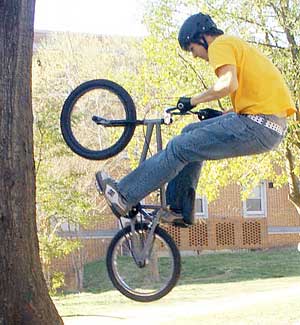Whoosh!
A bicyclist whips around the corner, zooming past a crowd of talking students and moving in and out of the groups of pedestrians, who are talking on their cell phones, listening to MP3 players and chatting to the people beside them.
Some students step to the side, giving the bicyclist room to pass, while others only move a few steps to the left, forcing the bicyclists to weave around the students. The sight of a bicyclist makes some students cringe, while others don’t even take notice.
“They need to stop riding in the middle of the road along yellow lines,” Josh McLaughlin, a junior in accounting, said. “Every time I’m waiting in traffic on Dan Allen [Drive] a bike flies past my driver-side door. It’s very, very frustrating.”
Chris Garland, a senior in psychology, said he feels the same way. He has grown frustrated with bicyclists who round corners too fast, run red lights and ride on the wrong side of the road.
“And they don’t wear helmets,” Garland said. “I rarely see a biker wearing a helmet, and the ones that are the most dangerous are often the ones that don’t wear them.”
McLaughin and Garland’s comments raise questions about what the bike laws are and if bicyclists are aware of them.
Sgt. Jon Barnwell from Campus Police said he feels there is ample educational material available for bicyclist on the Campus Police Web site and the Department of Transportation Web site.
Barnwell cited several bike laws he believes all bikers should know.
“As far as state law is concerned, a bicycle is a vehicle. It must primarily be used on the roadway and must obey all traffic laws,” Barnwell said. “And, when you’re on the roadway you need to be sure that you come to a complete stop at the stop signs and obey all traffic signals.”
Barnwell also advised bicyclists to use hand signals on the road to alert vehicle traffic to their movements and to avoid going the wrong way down one-way directional roads while on a bike.
“I didn’t even know there were bike laws,” Matt Nossel, a senior in Spanish, said. “I just try not to hit anything.”
Nossel began riding his bike this semester. Even though he said he was unaware of the bike laws, he does know the cut-off age for wearing a helmet is 16.
“I haven’t worn a helmet since elementary school,” Nossel said.
Brandon Hawkins, a student in Lifelong Education, said that he wears a helmet, but regrettably doesn’t follow all of the traffic signs or signals.
“I’m pretty dangerous on the road because I’m all over the place,” Hawkins said.
Benjamin Wingler, a senior in electrical engineering, said he was not aware that the bike held the status of a vehicle.
“I just ride my bike around and get to where I need to be,” he said.
Even though there are bicyclist unaware of the rules of the road, there are still students who know the rules.
Kevin Littlejohn, a senior in zoology, said he knew most of the bike laws. He learned the rules while taking driver’s education and learned the hand signals when he was in elementary school and has used them ever since.
Ed Cerne, a senior in history, said he knew all of the laws except one. Bicycles must have a front lamp visible from 300 feet away and a rear reflector visible from 200 feet away at night.
But luckily, he said, his new bike comes equipped with both.
“They make bikes idiot-proof these days,” Cerne said, also adding that he follows all of the bikes laws when riding on and off campus every day.
As for the bicyclists who do not follow the laws, repercussions exist — aside from the risk of crashing. Barnwell wants to remind students one-way streets apply to bikes, as well as vehicles. Violation of the bike laws can result in a citation or a ticket. The two most common bicycle infractions are exceeding safe speeds in pedestrian zones and riding the wrong way.
“The University prides itself in being safe for bicyclists and pedestrians and the only way we can do that is to make sure our bicycling public is also obeying the laws that are set forth out there,” Barnwell said. “It’s not to hinder them. It’s to maintain their safety.”








